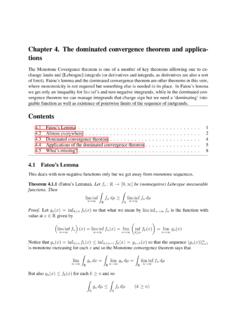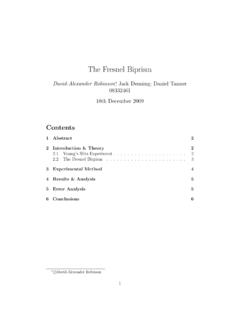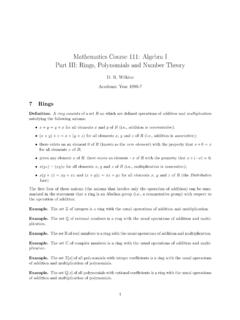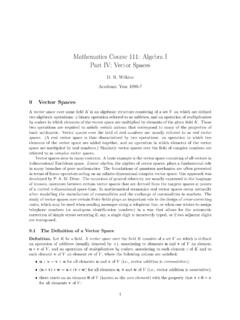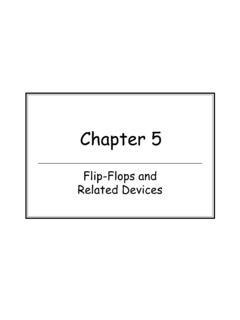Transcription of Types of Storage Devices - Trinity College, Dublin
1 Types of Storage Devices Physical components or materials on which data is stored are called Storage media. Hardware components that read/write to Storage media are called Storage Devices . Two main categories of Storage technology used today are magnetic Storage and optical Storage . Primary magnetic Storage o Diskettes o Hard disks (both fixed and removable) o High capacity floppy disks o Disk cartridges o Magnetic tape Primary optical Storage o Compact Disk Read Only Memory (CD ROM) o Digital Video Disk Read Only Memory (DVD ROM) o CD Recordable (CD R) o CD Rewritable (CD RW) o Photo CD Magnetic Storage Devices Purpose of Storage Devices to hold data even when the computer is turned off so the data can be used whenever needed.
2 Storage involves writing data to the medium and reading from the medium. Writing data recording the data on the surface of the disk where it is stored for later use. Reading data retrieving data from the surface and transferring it into the computers memory for use. Diskette drives, hard drives and tape drive all use the same type of medium use similar techniques for reading/writing data. Surfaces of diskettes and magnetic tape are all coated with a magnetically sensitive material such as iron oxide.
3 The principle use to store data is that of polarisation all the ions in the magnetic material align themselves in one direction. Just as a transistor can represent binary on or off , the orientation of the magnetic field can be used to represent data. A magnet has one important advantage over a transistor it can maintain it s state without a continual supply of electricity. Surfaces of disks are coated with millions of tiny iron particles so data can be stored on them.
4 Each particle acts as a magnet, taking on a magnetic field when subjected to an electromagnet. The read/write heads of a disk drive contain electromagnets, which generate magnetic fields in the iron on the Storage medium as the head passes over the disk. The read/write heads store a string of 1s and 0s by alternating the direction of the current in the electromagnet. To read data the process is reversed. The read/write heads pass over the disk while no current is flowing through the electromagnet.
5 The Storage medium has a charge and the electromagnet does not Storage medium changes the magnet in the head which causes a small current to flow through the head in one direction or the other depending on the polarity of the field. The disk drive senses direction of flow and data is sent from the head into memory. Magnetic Disks Diskette drives and hard disk drives are the most commonly used Storage Devices in PCs. Both fall into the magnetic Storage category because they record data as magnetic fields.
6 Fundamental differences and similarities between the two: A diskette contains a single flat piece of plastic (the disk) coated with iron oxide enclosed in vinyl or plastic cover. A hard disk contains one or more rigid metal platters coated with iron oxide permanently enclosed in a hard disk drive. Diskettes are small and portable (they can be removed from diskette drives). Hard disks are usually built into the computer and are not portable (unless the computer is). Exceptions are removable hard disks and external hard drives which can be detached from the system.
7 Floppy disks store only MB although special floppy disks offer higher capacity. New hard disks can store several thousand times as much data as a diskette. Hard drives are much faster than diskettes, their disks spin faster and they locate data on the disks surface in much less time. Almost all PCs sold today come with a hard disk and one disk drive. Some computers also feature a third built in magnetic device a device that uses high capacity floppy disks. How data is organised on a magnetic disk Before the computer can use a diskette to store data, the disks surface must be magnetically mapped so that the computer can go directly to a specific point without searching through all the data.
8 This process of mapping a disk is called formatting or initialising. When you purchase a new disk, they should be formatted for either PC or Mac. It may be helpful to reformat disks from time to time as this deletes all the data on disk. During the formatting you process you can also determine whether the disk has any faulty spots and you can copy important system files onto the disk. Hard disks must also be formatted so that the computer can locate data on them. When you buy a computer, the hard disk has already been formatted correctly and probably contains some programs and data.
9 You can format your hard disk if necessary but the process is different to that for a diskette. Modern diskettes store data on both sides of the disk (numbered side 0 and side 1) and each side has its own read/write head. When formatting a disk, the disk creates a set of magnetic concentric circles called tracks, on each side of the disk. The number of tracks required depends on the type of disk. Most high -density diskettes have 80 tracks on each side. A hard disk may have several hundred tracks on each side of each platter.
10 Each track is a separate circle. These are numbered from the outermost circle to the innermost, starting with zero. Each track on a disk is also split into smaller parts. Imagine slicing a disk as you would a pie. Each slice cuts across all the tracks resulting in short segments or sectors. A sector can contain up to 512 bytes. All the sectors are numbered in one long sequence so the computer can access each small area on the disk with a unique number.
